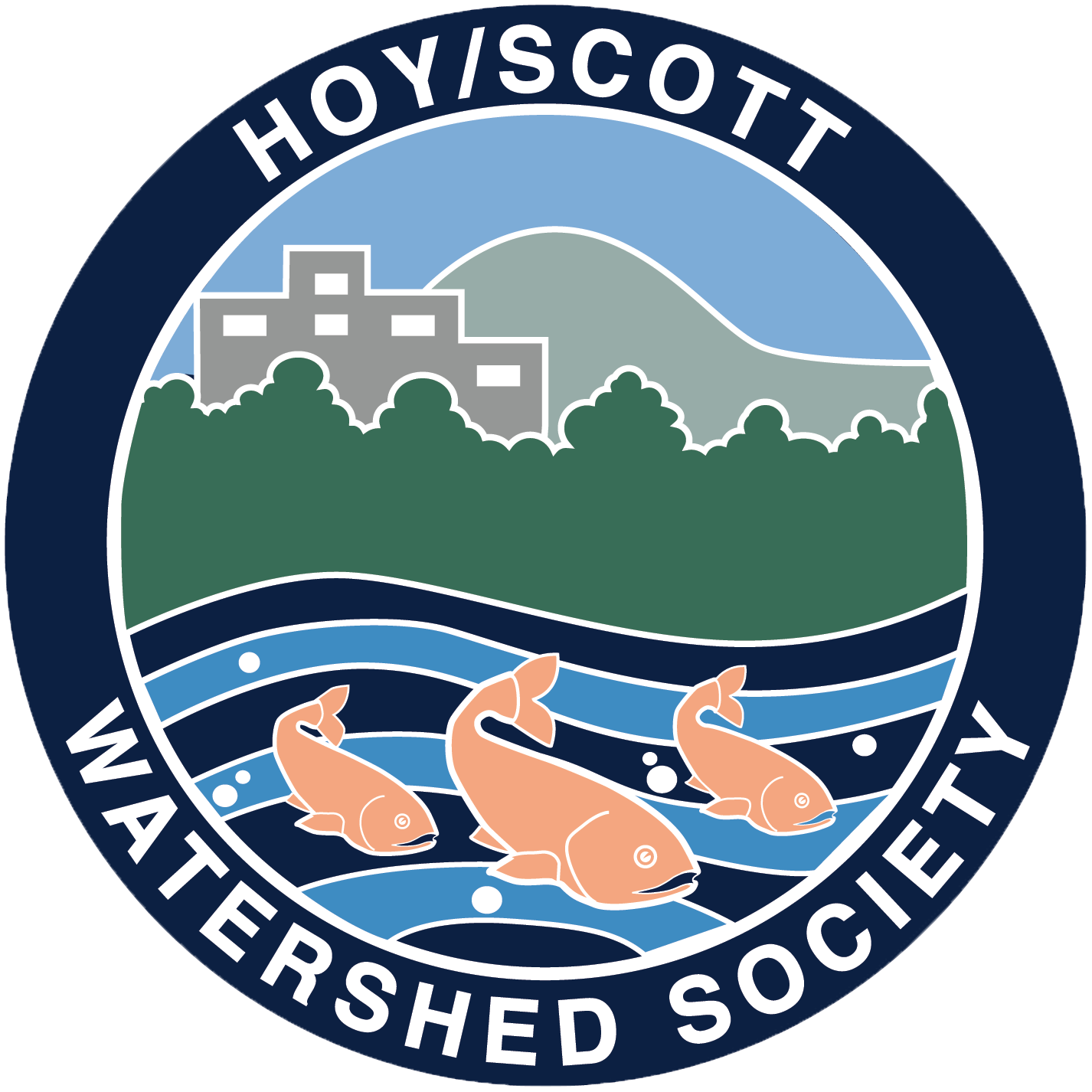Can you spot the salmon? (Photo: HSWS)
Nature has its own timing…
Each year there is an increase in the number of phone calls and emails the Hoy/Scott Watershed Society (HSWS) receives about the salmon return.
We’re often asked, “Can you tell me what day the salmon are returning?” or “Is there a less busy time to see the salmon?” or “I went to look in the creek but could not see any salmon. What is the best day to come?”
Rain is the most important ingredient. Once the rains return, the salmon follow.
While we know that chum salmon generally return in early October after the first heavy rains, there is no set date, and it fluctuates year to year. Our usual response to this question is to check our website or social media pages.
The good news is, chum and coho salmon have been spotted in Hoy Creek since Oct. 14, 2024.
Wait for the rain to subside and the water levels to lower to spot salmon. Heavy rain results in fast and high-moving water making it difficult to see the salmon.
Hoy and Scott creeks run through urban. private and public lands. You can view salmon any time you like from public areas like the Hoy Creek Linear Park, or beside Guildford Way or off Lansdowne Drive for Scott Creek.
A chum salmon in low creek water on a dry day may not be seen on a heavy rain day when water is rushing and the level is higher. (Photo: HSWS)
Tips for when and how to view:
Check first. It’s best to go once you’ve heard that the salmon have returned and have been spotted in the creeks (check our website or social media channels: Instagram or Facebook page).
After a rain, or on a clearer weather day. When the rains subside, creek depths lower, and this allows for the water to be quieter and more clear to see through.
Listen! You may often hear a salmon before spotting it. They move over shallow waters, or up over rocks or logs by flashing their tails making a splashing sound.
Look carefully. Salmon, in particular chum salmon, have similar colours to the rocks or stones in the stream and are therefore naturally camouflaged. Coho are even better at hiding than the chum. If you are expecting to see bright red salmon, you’ve come to the wrong creeks.
Sunglasses may help. Fishermen often wear polarized sunglasses to better spot fish in the water.
Resting places. Salmon have an arduous journey upstream. They can often be spotted under bridges or hanging branches or fallen logs to build up strength for their next climb.
Patience! Salmon may be right where you are looking, but they can be very hard to spot. Take lots of time. It’s often best to stay in one spot for some time to observe before moving further up or down the creek to try another area.
Don’t be discouraged. Salmon may not be out every day in the exact spot you are standing during the time you are there. The creeks are long. Try to come another day. When you finally do spot a salmon, you’ll be glad you did!
Location via Google maps. The Hoy Creek Hatchery is located on Hoy Creek Trail, west of the City Centre Aquatic Complex at the corner of Pinetree and Guildford Way. Simply Google "Hoy Creek Hatchery" to locate.
Hoy Trail has several entrances:
- Walk-in from Princess Cres. west of City Centre Aquatics Complex
and Lafarge-Lake Douglas Station;
- Walk-in from behind Douglas College and head south;
- Walk-in from Guildford Way (between Johnson and Pinetree) and head north;
- Walk-in from Walton Avenue, or behind Walton Elementary and head south;
- Walk-in from the foot of Lasalle Place and head northeast.
Salmon of Hoy and Scott Creeks:
Chum salmon begin to arrive in early to mid-October through to early November. Generally, the peak of the run is around the 3rd week of October. They have dark red and black stripes.
Coho salmon arrive in late October through to late December. Typically, the peak of the run is the 2nd or 3rd week of November. There are very few fish around into December but there has been the occasional year with good numbers of fish in the stream through to mid or late December.
During odd-numbered years (e.g. 2021), Pink salmon may be found in Hoy and Scott creeks from September to early October. They are not typically found in large numbers.
Although they don't favor smaller streams like Hoy Creek and Scott Creek, occasionally, Chinook salmon from the Coquitlam River find their way into the creeks. This may happen under heavy rainfall conditions when the water levels in our streams and rivers are high. The occasional fish find the current in the creek attractive and detour away from the heavier flows in the Coquitlam River.
Learn more about the lifecycle of the salmon.
Enjoy your salmon spotting!
"The salmon runs are a visible symbol of life, death and regeneration, plain for all to see and share ... The salmon are a test of a healthy environment, a lesson in environmental needs. Their abundant presence on the spawning beds is a lesson of hope, of deep importance for the future of man."
-- Haig-Brown, 1974 (The Salmon)


